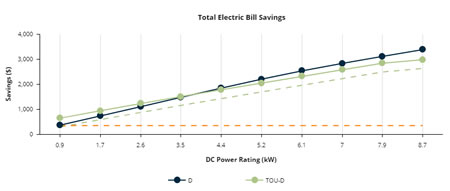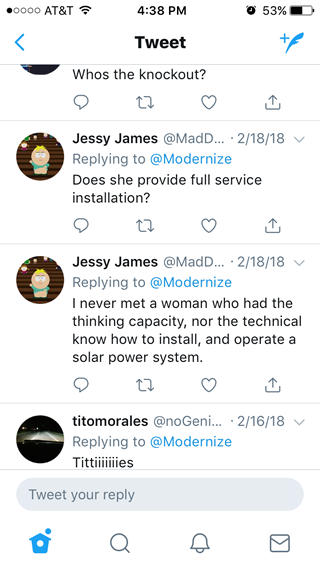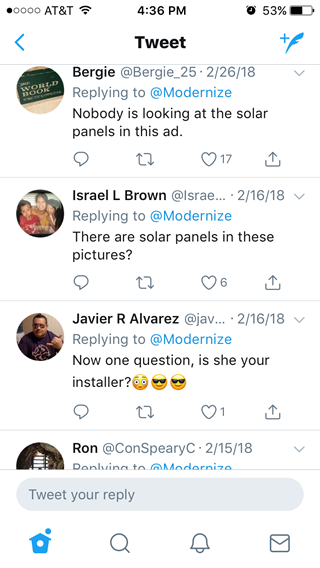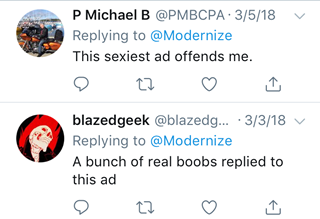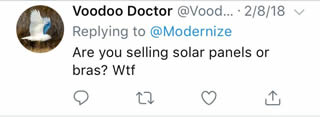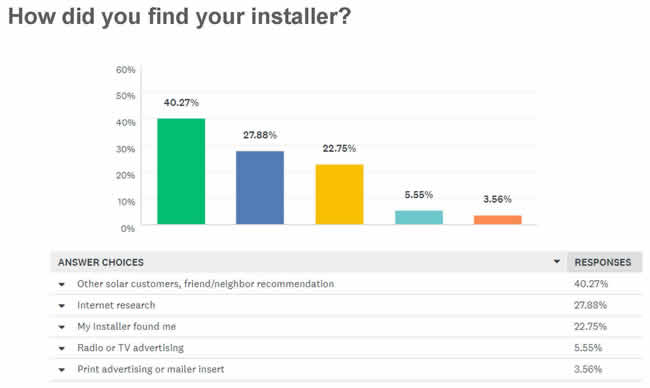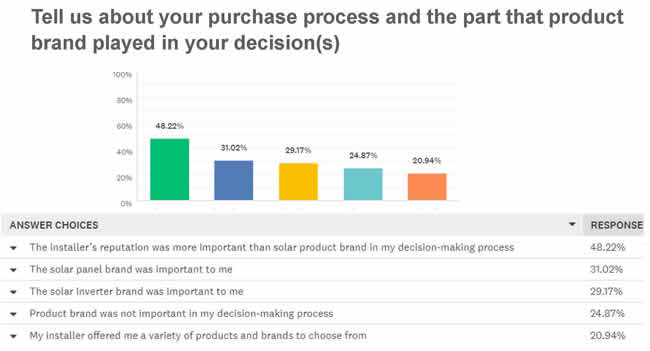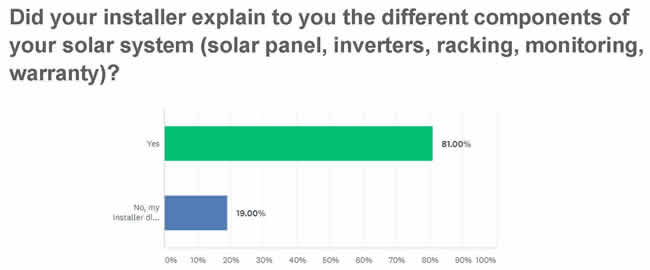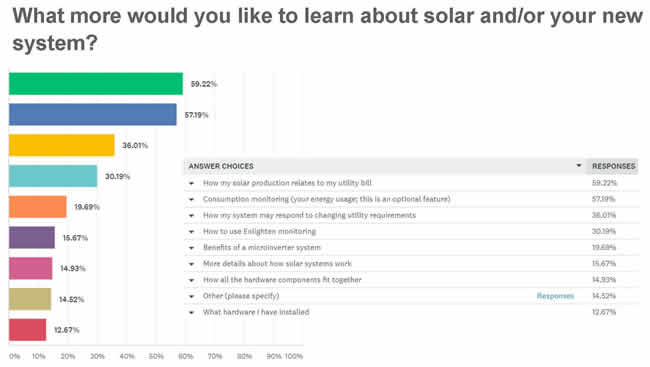Welcome to the
Run on Sun Monthly Newsletter

In this Issue: |
April, 2018
Volume: 9 Issue: 4
My Electric Bill is So High! Will Solar Help? Part 1: How High is High?[EDITOR'S NOTE: This is the first of our three-part series. Read part 2 here; read part 3 here.] We hear it all the time: "My electric bill is so high, I just want to stick it to [insert name of utility here]! Can solar help?" Now we are in the business of selling and installing solar, so our preferred answer is, "Of Course!" But that is not always the answer we end up giving. So Part 1 of this three-part series focuses on that electric bill to answer a few questions first: 1) How high is it? 2) What can you do to make it lower - pre-solar? And 3) Is your home even a good candidate for going solar? Let's look at each in turn... How High is High?Ask most any consumer how high their electric bill is and they will all pretty much tell you -- too high! So let's recognize a few things at the start: if you are a PWP or DWP customer, your electric bills will be lower than your compatriots sufferi, er, living, in SCE territory. SCE bills monthly, whereas PWP and DWP bill (roughly) every two months. Most non-solar, residential customers are on a tiered rate structure - that is, the more you use, the more you pay for what you are using. That said, not all tiered rates are alike: SCE has a true, three-tier rate structure where the cost increases in each subsequent tier, whereas PWP has a bizarre structure where the "highest" tier is actually cheaper than the middle tier! (I wonder how many PWP customers realize that perverse incentive?) Taken together, what can you say about how high is high? We would break it down roughly this way:
To illustrate how and why that works, let's look at the modeling that goes into sizing your system. (For this analysis we made use of Energy Toolbase, one of the most sophisticated tools available for modeling the performance of PV systems and producing comprehensive, authoritative and transparent solar proposals.) We created three different usage profiles corresponding to the categories set forth above. All were SCE customers under the current Domestic rate structure in region 9 (i.e., Altadena). The first had usage such that their average bill was under $100/month. The second had bills between $200 and $300/month, and the third had bill in excess of $450/month. In each case, summer usage was higher than the rest of the year.
Energy Toolbase allows an installer to run multiple simulations of total bill savings based on the size of the system to be installed. On the right is that output for our middle-case client. It's a little hard to see in the small version of the graph (click on it for larger), but the light green line (which represents the savings under the new, SCE-forced rate structure) levels off at 7.9 kW. That inflection point means that a system sized larger than that is no longer providing a full economic benefit to the client. We performed similar analyses for the other two use cases to determine the optimal system size, and to then determine their savings and payback. Here are our results:
As system size increases, even without assuming any improvement in price based on economy of scale (the system price in each case is $4.00/Watt), it is clear that larger systems have significantly greater return on investment over the life of the system. If your bills fall into that third use case, you are going to benefit greatly by adding solar. But in that first use case, not so much. What can you do to make your bills lower -- before adding solar?However, even if your use case makes sense, it is important to consider some low-hanging fruit before plunking down thousands of dollars on a solar power system. The two most obvious candidates for investment are pool pumps and air conditioning systems. Pool PumpsOlder pool pumps tend to have single speed motors, which means that they draw the same amount of energy all the time. But harken back to your elementary school science classes: a body at rest tends to stay at rest; a body in motion tends to stay in motion. (Thank you, Isaac Newton!) What's that got to do with pool pumps? Well, all that water in your pool has a lot of mass and when it is just sitting there it takes a great deal of energy to get it moving - it's a big body at rest! But once you get it moving, it is relatively easy to keep it moving, so you need to expend a lot less energy to do so. Single-speed pool pump motors don't get that, and they just keep pumping as hard as they can the entire time they are on. That is wasteful, and expensive. A variable-speed pump, on the other hand, embraces the eternal wisdom of Sir Newton, and throttles down over time. That saves energy, and thus money. Even better, utilities like SCE will give you a rebate (from SCE that is $200!) toward the cost of installing a variable-speed pool pump. Updated A/CThe other big opportunity for savings is in an updated A/C system. Newer systems are significantly more efficient out-of-the-box, and as older systems age, their efficiency decreases, meaning they are costing you more to operate. Other Savings OpportunitiesYou don't really have an old refrigerator running in your garage, do you? If it is old, it is inefficient, and you've just put it in the hottest part of your home (short of the attic) so it has to work really hard to keep that case of beer cold. Either ditch it altogether, or only run it when that party is about to happen! How old is your thermostat? Does it even work, or do you just use it as an on/off switch? New, smart thermostats can save you money - and there is likely a rebate there, too! How good a candidate is your home for solar?Ok, your use case is compelling, even after harvesting all that luscious, low-hanging fruit. So is it now certain that solar will help? Um, maybe. How good of a candidate is your home for solar? We have written about this at length before, for example here and here. If you have lots of shading, your house will not be a good candidate -- you don't want to be the owner of a system installed under a tree! But other issues can change the value proposition for installing solar. For example, your electrical service might be ancient and undersized, requiring you to spend additional money to upgrade to a newer, larger service. If you are installing a relatively large PV system, that is a relatively small increase, but on our small use case, upgrading your service panel can add 10 to 15% to the total cost. Other factors that are not show-stoppers but which increase costs are second-story and/or steeply pitched roofs (both of which just make the labor costs higher because the work goes slower), roofs other than composition shingles, service panels located far from where the array needs to go (like the array on a detached garage but the service panel in on the side of the house with a concrete driveway in between). How can you know for sure? Simple, have a professional installer come out and do a proper site evaluation. So how do you find such a person? Ah, that is the subject of Part 2: How Do I Find Someone to Trust? |
“Ask most any consumer how high their electric bill is and they will all pretty much tell you—too high!”
Get your copy of
Commercial Solar:
Step-by-Step
from
Run on Sun
Founder & CEO
Jim Jenal

Now available on Amazon.com
in both
Print & Kindle versions.
Bonus - Buy the Print version…
Get the
Kindle version for Free!
Commercial Solar:
Step-by-Step
from Run on Sun
Founder & CEO
Jim Jenal

Now available on Amazon.com
in both Print & Kindle versions.
Get the Kindle version for Free!
Help Us Spread the News!


Do "Boob" Ads Sell Solar?[Editor's Note: Run on Sun's Project Coordinator, Sara Pavey, takes on a disturbing trend in solar advertising, and she does so with passion. Warning: May be NSFW!] The ad above was trying to sell us leads. Mind you, Run on Sun does not now, and never has purchased leads, but for some reason all of my online searching was dominated by these ads.
Now, it’s all fine and dandy to suggest that you steer clear of these ads. But my bigger issue with this ad is that they are using BOOBS to generate leads that will ultimately send a sales rep to a home. Is the solar company’s appointment setter going to get the creeper question, “Was that you in the ad? Huh huh huh?” Is that sales rep assigned to this lead going to be a woman who gets to go meet with a potential new client who was first drawn in by a terrible ad? Is this the type of ad that is going to win over the marketing director at a solar company? Does HR want their reps going solo to homes when the leads came from a creepy irrelevant boob ad? I have my doubts about the quality of leads coming from boobs carrying a heavy box with a tiny solar panel kit, but what do I know about marketing? What I do know, as a woman in a technical industry, is that even in our sunny egalitarian utopian solar industry, there are more men than women, there are plenty of skeevs and pervs, and there is still a lot of work to be done before Solar can claim that it’s not a sexist industry. Make no mistake, it’s better than a lot of other industries. But we can do better. In case you’re curious about the fine quality of humans who noticed the Twitter ad, here is an abridged micro-sample of typical responses. Decide for yourself how effective this ad campaign is:
As a woman who meets with potential clients, I have zero interest in meeting with people who came to us because they clicked on the boobs link. The number of women in the industry is growing rapidly. At last count, women made up 27% of the workforce. Plenty of women are going solo to sales calls with homeowners who may be total dirtbags and are only interested in the boobs. Most of the people who takes calls at your local solar company are women – and we just looove it when the caller, a potential client, has feedback on how pretty we must be because of the sound of our voice. Many of the people in marketing, rebate processing, interconnection processing, design, project management, finance, and HR are women. We don’t have lingerie-clad boothbabes (anymore) and we don’t need boobs to sell solar. Solar is cool enough to stand on its own. When the industry is using boobs to sell a product, and a quarter of the people in the industry are objectified by the ads, there is a problem. Using boobs to sell something is nothing new, but I wonder how often they appear in other product marketing in industries where women are alone with potential clients? How many realtors depend on photos of boobs in front of a home to sell that house? How many doctors have a photo of boobs in their exam room to drive new patient business? How many dentists have ads showing boobs getting their teeth x-rayed? There’s a big difference between a Realtor’s glamour shot and this ad. Mercifully, we found plenty of people who were completely turned off by the ad:
So, all hope is not lost for humanity, but I have my doubts about the quality of leads from an ad like this. And if I were at a company that bought leads, I would look elsewhere for those services. Or I’d let HR know that I set my team up for some unpleasant experiences. |
Why does a Solar Client Choose Enphase?Our friends over at Enphase Energy just completed their most recent survey of solar clients who chose Enphase for their PV system. Since all of our clients for years now have benefited from having an Enphase system installed, the insights that Enphase gleaned are pretty relevant to understanding our clients here at Run on Sun. So what did they find out? Enphase identified three goals for their survey: Determine how homeowners decided to go solar and choose their installer; assess the role of brand name products in the purchasing decision; and see what, if any, questions remained unanswered. Let's take those one at a time. How Enphase Customers Chose Their InstallerSolar companies employ a variety of strategies for finding new clients, from door-to-door canvassing or cold calling leads, to print, radio, or TV advertising, as well as word of mouth. Of course, all but that last avenue can be trod simply by throwing money at the problem. Hence the very high cost of acquisition that we see for some of the national chains, in some cases upwards of $3,000/client! How did Enphase customers choose their installer? The results are quite interesting: Now that is interesting - over two-thirds of Enphase customers found their installer either by referrals or from doing their own Internet research! This tracks very closely with our own experience: we don't purchase leads, we don't cold-call people, and we don't go knocking on their doors. We do devote a lot of energy to having a quality Internet presence (via both our website and this blog), and a significant percentage of our new clients are referrals from our earlier ones. It looks like we are meeting Enphase customer where they are looking! It is interesting to see that third result - "My installer found me" - clearly represents all of those things we don't do! So that explains why you are still getting dozens of calls and knocks on your door asking you to go solar -- for 1 in 5 customers that approach works, at least when it comes to signing on the line that is dotted! (Actually, we use a solid line, but that's an issue for another post!) Oh, and those other forms of advertising? Looks pretty much like money down the drain -- ouch! The Importance of Product BrandingSo now we know how these Enphase customers found installers to consider, but how did they make their purchase decision? Survey says: Not surprisingly, the installer's reputation was the most important factor, cited by nearly half of all respondents -- which dovetails nicely with choosing the installer based on referrals. At roughly 30% each, the brand name of the solar panel, and the inverter was important in the decision. This is interesting to me, and consistent with our experience. Maybe one client in three has a strong view on either the panel or the inverter when we first speak with them. Of course, that means LG and Enphase because that is all that we install. I suspect if you were to look at this question five years ago, the number of respondents saying brand was important to them would have been much smaller. Oh, and again, the survey shows that we are missing out on one in five potential clients since their installer offered a variety of products from which to choose. In our view that is something of an abdication of our responsibility as pros. Our clients want to rely upon our expertise to guide them to the right choice -- how are they supposed to know what it the best inverter or solar panel out there? Questions, questions!An important part of the installation process is to manage client expectations, and a key component of that is to answer their questions. So how good a job are installers doing at answering those questions? Survey says: The overwhelming number of Enphase installers are answering their clients questions -- good job! But interestingly, about one in five clients are being left in the dark about questions that they had regarding their systems. (I wonder if this is the same one in five who had the installer find them?) For folks who have questions, what is it that they most want to know? Again, these open questions reflect on the need to manage expectations: Not surprisingly, the number one question, asked by a 60% of respondents, is how does the production from the solar system relate to their electric bill! This is an extremely common concern -- leading to that famous complaint: I've got solar, why is my bill so high? I think the evidence is overwhelming that solar installers need to do a better job of explaining how these systems will work in real life. Are you a recent solar consumer? How do these results match up with your experience? We would love to hear your thoughts/experiences in the comments! |
